Picto Diary - 23 January 2017 (PM) - TRIFECTA
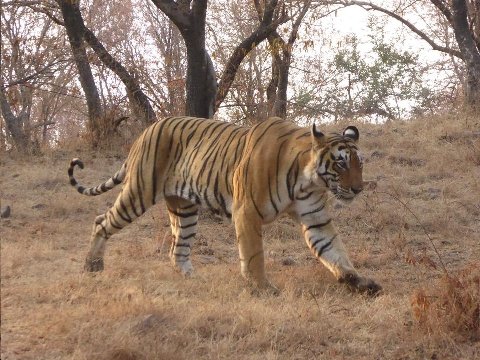
Above: TIGER! My camera shot. Lumix. Leica lens. Zone 4 Ranthambore National Tiger Reserve. 23 January 2016. Rajesthan, India. "Star Male." T-24.
4:45 PM. Jeep headed direction park entrance to make 5:30 "leave the park" deadline. I'm steeling myself, at the end of my fourth and last 3 hour safari tiger search, to an "unsuccessful" visit. Well... the birds were nice! I saw a bunch of crocs. Two jackals mating... it wasn't all a bust.
Then...
Naturalist Salim notices that Sambar deer on left side have their tails up. Its a sign of worry. Salim asks jeep driver to slow. 200 yards distant, by the shores of a lake, we see and hear seven or eight wild boars screaming and running from something.
Then. Look! There he is T-24, walking slowly along the lake shore. Salim, wanting a closer view, instructs driver to reverse and vector to where the believes the tiger is headed.
Doubting Salim's judgement about getting closer to the animal, I say to myself, "well... at least I saw a tiger from a distance. I won't go home empty handed! How does Salim know the tiger is coming to the new spot? Aw... he's not coming. He went another direction!"
Suddenly, after we have been parked for over three minutes on a ridge line above the lake, T 24 appears. He's walking up the ascent to our right.
Voila... these two and many other shots.
Animal walks slowly by, seemingly indifferent to Salim, me and the driver in the jeep. Salim says, tigers born in the reserve become used to the jeeps and don't see them or those in them as a threat. Out of the jeep, however, a human would be very much in danger.
Once in a lifetime animal sighting! Awesome beast! The tiger sighting experience inspires awe... reverence...
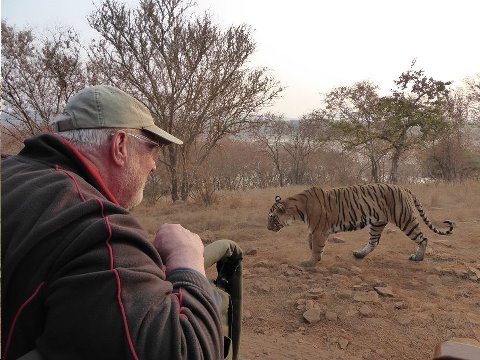
Above: TIGER! Bishop and T 24. Ranthambore National Tiger Reserve. Rajesthan, India. 23 January 2017. Image captured by Salim with my Lumix Leica lens camera.
To balance the record, this was not my first tiger sighting in the wild in India. In 1972 Delhi PJ's and Mwah (sic) drove from Delhi to Sariska Tiger Reserve near Alwar. Our sighting was at night, about 9:00 PM. In those days, they tied up a goat and waited for a tiger to come in for the kill. Not very sporting... but, we witnessed the sordid tiger meal.
During the 70's and 80's the Sariska tigers were all poached. For years there were no tigers present. In 2014 the authorities moved 13 tigers from Ranthambore, where there were too many tigers relative to the tigers' requirements for territory, to Sariska. I am told one or two of those tigers died due to illness... but, apparently, the other tigers thrive and there have been several cubs born in the last two years.
Indian authorities seemed to have reversed the tiger extinction trend of the '70's and '80's. There are now 2000 reported tigers in India in 30 or so reserves spread throughout the country. The largest number of tigers, over 100, is in Sundarbands National Park, West Bengal. Because of tall grass, and swampy terrain, tigers there are rarely spotted. Sundarbands is known for man eaters. There have been four villagers killed in the last twenty years. Man eating tigers are not killed. They are shipped off to zoos. Also sent to zoos are crippled tigers or tigers, which, for whatever reason, are not able to fend for themselves in the wild.
Ranthambore is said to be the best place to see a tiger in the wild. The area is semi arid with a lot of open space and visibility potential. I first saw T-24 from over 200 yards away down by a lake. I tried unsuccessfully to capture a telephoto image, but he was so far away I had a hard time getting him in the view finder. I was resigned to the fact that this distant sighting was as close as I would get, until Salim, my hired naturalist, vectored the vehicle to a spot on a hill above the lake some quarter mile from my first sighting, where T 24 five minutes or so later, walked right by us. According to Joseph, major domo of Sher Bagh, our tent camp, less than 50% of visitors to Ranthambore see a tiger. Ie. Despite Ranthambore being best in India for tiger spotting, there is no guarantee you'll see one. I talked to one disgruntled American from Maryland on the night of his second day of safaris. He had been out four times and had seen very little... not to mention a tiger. He said his wife sent him on the trip and that he would never return to India again.
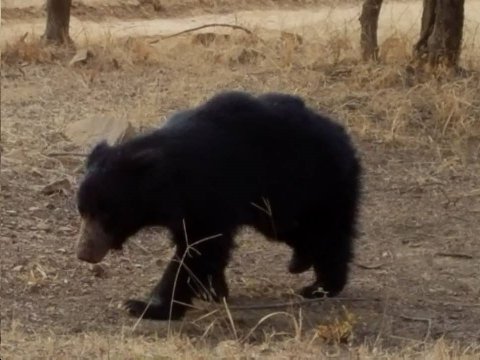
Above: SLOTH BEAR!
Just 5 minutes after sighting T024, as we were driving towards the exit of Zone 4, we come upon this bear. There are two other vehicles already there. My photo image above on the Samsung phone.
According to Salim, sloth bears are rarely seen at Ranthambore.
Trifecta this afternoon. Tiger, sloth bear (shown here... rare to be seen in park), and leopard. Other images on the Lumix await flash card transfer to computer and upload to FB.
I was preparing to leave Ranthambore empty handed. And now, in this final hour of 12 hours (four outings) of searching, an embarrassment of animal sighting riches. Luck? Serendipity? Karma? Or, maybe my naturalist, Salim's karma?
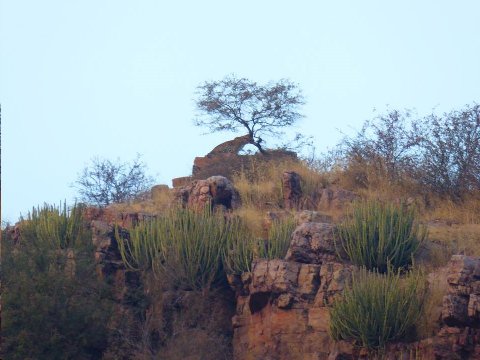
Above: LEOPARD!. Sited 23 January 2017. Rambathore Tiger Reserve National Park. Rajesthan.
Sited after seeing the tiger and the sloth bear as we were leaving the park, beyond the exit from Zone Four. The siting wasn't a great sighting as the leopard was on a rock at the top of a hill... likely more than 200 yards away. I took this image at 30x with the Lumix. This is why i brought the Lumix... for distant animal sightings. I'm happy with the outcome. An image taken by the Samsung S7 Active, at 8x, would have shown nothing. Since I'm not an "in to it photographer" the Lumix suits me just fine.
You can do an optical zoom and see the animal's spots. Since the sighting was on the common road leaving the park there was a gaggle of other spectators there watching. This completes my trifecta... tiger, sloth bear, and leopard... all seen in the last hour of the last of four safari outings.
We saw two leopards just a year ago at the Sajan owned Jawai Leopard Camp near Udaipur. The best sighting that visit also occurred, unexpectedly, at the very end of our last safari outing.
Serendipity rules.
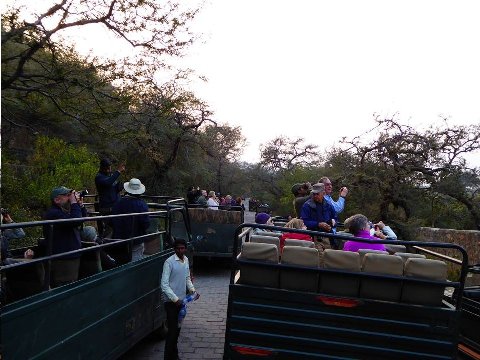
Above: A gaggle of animal watchers at the leopard sighting. Ranthambore National Tiger Reserve. Rajesthan. 23 January 2017.